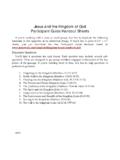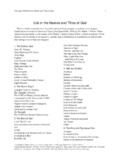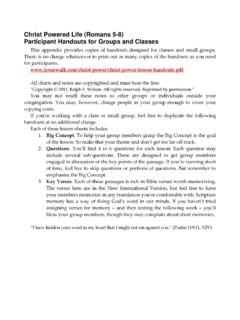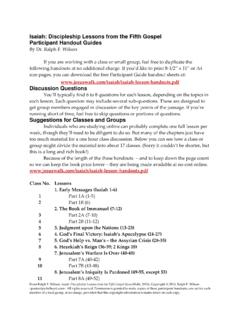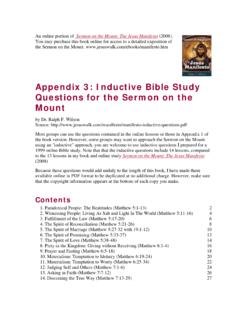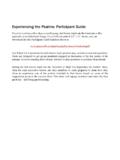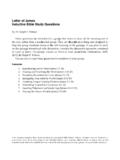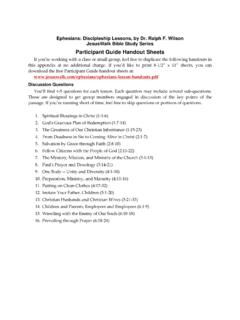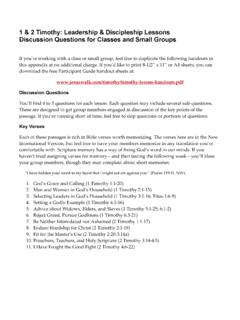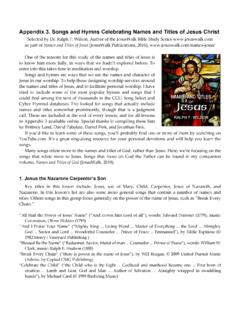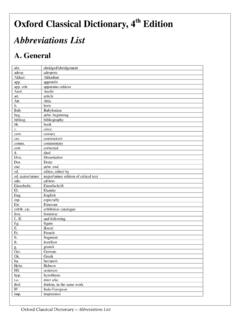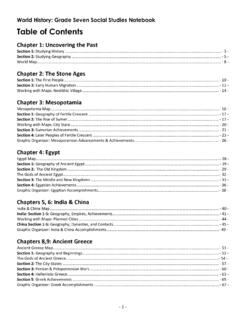Transcription of Resurrection and Easter Faith Participant Notes for ...
1 Resurrection and Easter Faith Participant Notes for Classes and Groups If you're working with a class or small group, feel free to duplicate the following handouts in this appendix at no additional charge. If you'd like to print 8 1/2 x 11 sheets, you can download the free Participant Guide handout sheets at: lesson Discussion Questions You'll find several questions for each lesson. Each question may include several sub questions. These are designed to get group members engaged in discussion of the key points of the passage. If you're running short of time, feel free to skip questions or portions of questions. The Notes include an outline and condensation of the lessons particularly the scripture references plus the discussion questions.
2 1. The Promise of Resurrection from the Dead 2. The Gospel Accounts of Christ's Resurrection from the Dead 3. Convincing Proofs of Christ's Bodily Resurrection 4. The Present Day Significance of Christ's Resurrection 5. The Christian Hope of Resurrection at the Last Day Participant Notes for Resurrection and Easter Faith 2. 1. The Promise of Resurrection from the Dead Resurrection Defined Resurrection : Something more than a resuscitation after near death. Rather a raising up of the body after a period of being dead. Old Testament Beginnings Gathered to his fathers (Genesis 25:8). Hebrew word she l, the place of the dead, both good and bad. Seems to refer to the dark, deep regions, the land of forgetfulness.
3 A place of gloom and despair, a place where one can no longer enjoy life, and where the presence of Yahweh himself is withdrawn. Psalm 6:5. Psalm 88:10 12. A Growing Hope of Resurrection Progressive revelation. Job 14:14. Job 19:25 27. Q1. How does Jobs vision of Resurrection (Job 19:25 27) differ from the Jews former understanding of death as Sheol? What is progressive revelation? Psalm 16:9 11. Hosea 13:14. Hosea 6:1 2. Isaiah 26:19. Isaiah 53:11. The phrase light of life (NIV) doesn't occur in the Masoretic Hebrew text, but is found in both the Greek Septuagint translation as well as the Hebrew text of the Isaiah scrolls found among the Dead Sea Scrolls. Ezekiel 37:1 6.
4 Daniel 12:1b 2. First Century Judaism There were essentially three beliefs about the Resurrection in Jesus' world. 1. Sadducees. Acts 5:17; Matthew 22:23; Acts 23:8. 2. Pharisees 3. The Greeks and Romans (Acts 17:18, 32). Jesus' Teaching on the Resurrection of the Dead John 5:28 29. Acts 24:15. Luke 14:14. Q2. (John 5:28 29; Acts 24:15) According to scripture, both the righteous and unrighteous will experience Resurrection . What will be the result of Resurrection for the righteous? Luke 20:34 36. Luke 20:37 38. From Ralph F. Wilson, Resurrection and Easter Faith (JesusWalk, 2011). Copyright 2011, Ralph F. Wilson All rights reserved. Permission is granted to make copies of these Participant handouts, one set for each member of a local group, at no charge, provided that this copyright information remains intact on each copy.
5 Participant Notes for Resurrection and Easter Faith 3. Jesus' as the Agent of Resurrection John 11:23 25. John 5:25, 28 29. John 6:39 40, 54. Q3. (John 11:23 25) What do you think Jesus meant when he said, I am the Resurrection and the life? What role will Jesus play in the Resurrection of the dead? Jesus' Promise of His Own Resurrection Matthew 16:21. Matthew 17:22-23. Matthew 20:17-19. The Third Day, Three Days John 2:18 22; remembered by his enemies. Matthew 27:40; Mark 14:58. Matthew 12:39 40. Matthew 27:62 64. Q4. Why did Jesus' enemies heed his prediction of being raised on the third day even more than his disciples? Did his enemies expect him to rise? Did his followers?
6 From Ralph F. Wilson, Resurrection and Easter Faith (JesusWalk, 2011). Copyright 2011, Ralph F. Wilson All rights reserved. Permission is granted to make copies of these Participant handouts, one set for each member of a local group, at no charge, provided that this copyright information remains intact on each copy. Participant Notes for Resurrection and Easter Faith 4. 2. The Gospel Accounts of Christ's Resurrection from the Dead Before beginning, read the Resurrection accounts in the Gospels. Try looking at them as for the first time. Ask yourself: What happened here that prompted these stories? Look for differences as well as similarities. Matthew 28:1 10, Mark 16:1 14, Luke 24:1 44, John 20:1 29.
7 If you like, print out an online version that shows the Gospel Resurrection accounts in parallel (NIV). The Synoptic Problem Synoptic Gospels Matthew, Mark, Luke Q, which stands for the German word Quelle, meaning source. Mark earliest gospel, Mark 16:9 19, the so called longer ending of Mark Matthew Palestinian Jews Luke Hellenistic audience John eyewitness Resurrection Differences 1. Women. In the Synoptic Gospels, Mary Magdalene and other women go to the tomb. In Johns account, Mary Magdalene goes alone. 2. Appearance to the women. In Matthew 28:9, Jesus appears to the women before they tell the disciples. In John 20:13 17, Jesus appears to Mary Magdalene first (also in the longer ending of Mark) after she reports to the disciples.
8 In Mark, the women tell no one of what they had seen. 3. Number of angels. In Matthew and Mark one angel appears; in Luke and John there are two angels. 4. Purpose of the women's visit. In Matthew they go to look at the tomb. In Mark and Luke they bring spices to anoint Jesus' body. In John the anointing took place on Friday night and no purpose for Mary s visit is given. 5. Grave clothes. In Matthew and Mark, Jesus is wrapped in a large linen shroud (sidr n). In John 19:40; 20:5 7 and Luke 24:12, Jesus is wrapped in strips of linen (othonion). See the discussion below. 6. Location. In Matthew and Mark, Jesus' Resurrection appearances are in Galilee, while Luke only records appearances in the vicinity of Jerusalem.
9 From Ralph F. Wilson, Resurrection and Easter Faith (JesusWalk, 2011). Copyright 2011, Ralph F. Wilson All rights reserved. Permission is granted to make copies of these Participant handouts, one set for each member of a local group, at no charge, provided that this copyright information remains intact on each copy. Participant Notes for Resurrection and Easter Faith 5. Eyewitness Accounts Q1. What differences do you find between the various Resurrection accounts? How do you account for differences in eyewitness testimony? How might these differences add to the credibility of the witnesses? Points of Agreement 1. Jesus was dead and buried. 2. The disciples were not prepared for Jesus' death.
10 They were overcome with confusion. 3. The tomb was found on Easter morning to be empty. But this in itself didn't inspire Faith . Mary thought the body was stolen. 4. The disciples encountered certain experiences which they took to be appearances of Jesus risen from the dead. 5. Contemporary Judaism had no concept of a dying and rising Messiah. 6. The disciples proclaimed the Resurrection of Jesus in Jerusalem, near where he had been buried What Happened Easter Morning? 1. Mary Magdalene saw him first and spoke to him (Mark 16:9, longer ending; John 20:16). 2. Other women also saw him and touched him (Matthew 28:9). 3. Jesus appeared to Peter and the other apostles (Luke 24:34; 1 Corinthians 15:5; Mark 16:14 longer ending; Luke 24:36).
